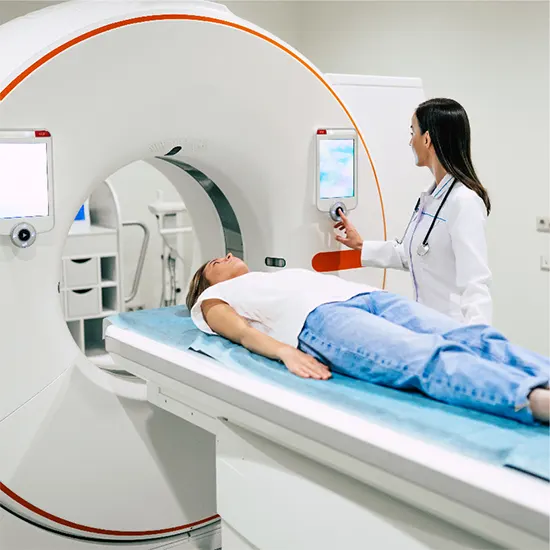
What is CT Coronary Angiography? To create comprehensive images of the blood vessels in the head and neck region, a computed tomography (CT) scanner is used in the medical imaging procedure known as CT coronary angiography.
What is CT Coronary Angiography?
To create comprehensive images of the blood vessels in the head and neck region, a computed tomography (CT) scanner is used in the medical imaging procedure known as CT coronary angiography.
Aneurysms, blockages, and abnormalities in the blood arteries are just a few of the problems that can be diagnosed using this non-invasive technique.
A contrast material is injected into the patient's veins during the CT coronary angiography process to aid in the clearer visualization of the blood vessels.
A radiologist examines the CT scanner's finely detailed images of the blood arteries created using X-rays to look for any abnormalities or diseases.
The average time to complete a CT coronary angiography is about 10-15 minutes. It is a relatively simple and safe procedure.
It is an effective diagnostic technique that enables medical professionals to choose the most appropriate course of treatment for problems affecting the blood vessels in the head and neck region.
Procedure
The key procedures for a CT coronary angiography are as follows:
Preparation of Patients
The patient will be requested to take off any jewelry or other metal items as well as any clothing that could obstruct the imaging method before the operation.
Also, if contrast dye will be used, they might be requested to fast for a few hours before the operation.
Any drugs being used, especially blood thinners or other anticoagulants should be disclosed to the doctor by the patient.
Infusion of Contrast Media
Typically, a contrast substance is injected into the patient's veins to produce clear images of the blood arteries.
The dye used as the contrast material helps to highlight the blood vessels, which makes it easier to spot them in the subsequent photographs. The dye can be injected into an arm artery or given intravenously (IV) through an IV line.
The warmth that the injection may cause to spread throughout the body is natural and normally passes within a few seconds.
Iodine is typically utilized as the basis for the contrast medium in CT coronary angiography. Although it is generally safe for patients, there could be some adverse effects, like a warm sensation or metallic taste in the mouth.
Rarely, patients may have an allergic reaction to the contrast material. These reactions can range from minor ones like itching or hives to severe ones like anaphylaxis.
Patients should let their doctor know if they have any allergies or illnesses, especially kidney-related ones, to reduce the risk of problems from the contrast material injection.
Those who have kidney issues may be more likely to develop contrast-induced nephropathy, a disorder that can harm the kidneys, as the contrast material can be filtered by the kidneys.
Imaging Method
The patient will recline on a CT scanner bed, which will slowly move through the machine after the contrast dye has been delivered.
The contrast dye aids in separating the blood vessels from the surrounding tissue in the CT scanner's X-ray images of the blood vessels.
During the imaging procedure, the patient could be instructed to hold their breath for a few seconds to prevent motion artifacts from impairing the sharpness of the images.
To construct a 3D image of the blood vessels in the head and neck region, the CT scanner will produce images of the blood vessels from various angles. It normally takes 10 to 15 minutes to finish the scan.
Analyzing Data
A radiologist, who specializes in medical imaging, examines the CT scan results after it is finished. The radiologist will look through the pictures to evaluate the state of the blood vessels and spot any anomalies, such as blockages or bulges.
The radiologist may also make comparisons between the images and earlier scans or imaging investigations to monitor the development of a specific medical problem.
Care After Surgery
The patient will be watched closely for a short while following the CT coronary angiography treatment to make sure there have been no negative responses to the contrast material.
The patient could be instructed to drink a lot of water to help the dye leave their system. After the treatment, the patient can get back to his or her routine.
Problems and Hazards
CT coronary angiography carries some risks and problems, just like any other medical procedure. The most frequent adverse effect is a slight allergic reaction to the contrast substance, which might result in symptoms like swelling, itching, or hives.
Though uncommon, more serious allergic reactions can occasionally happen. Infection or bleeding at the injection site as well as radiation exposure from X-rays are other potential dangers. However, most patients have no issues and the procedure's advantages typically outweigh its dangers.
As a whole, CT coronary angiography is a helpful imaging method that can support the diagnosis of health issues involving the blood arteries in the head and neck region. The process entails injecting a contrast dye into the patient's veins, using a CT scanner to scan the blood vessels, examining the resulting images to spot any anomalies, and monitoring the patient for any negative reactions to the contrast material.
Although there are certain dangers involved with the operation, they are typically small, and the majority of people have no problems.









